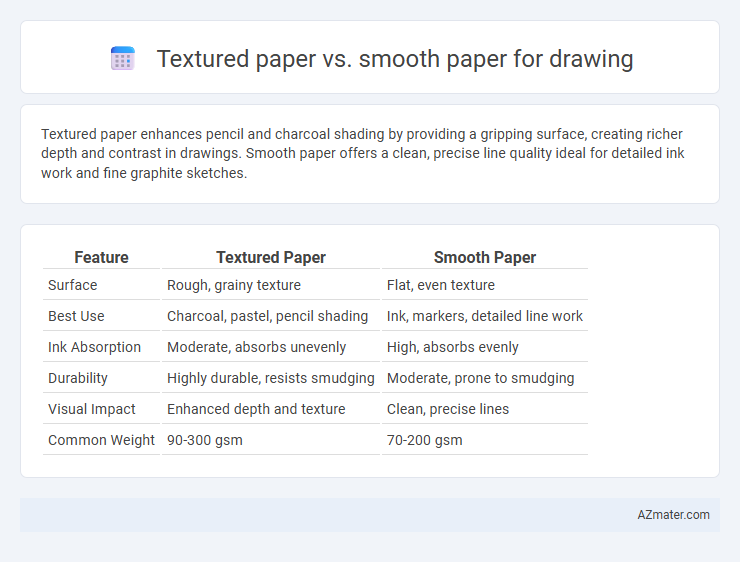Textured paper enhances pencil and charcoal shading by providing a gripping surface, creating richer depth and contrast in drawings. Smooth paper offers a clean, precise line quality ideal for detailed ink work and fine graphite sketches.
Table of Comparison
| Feature | Textured Paper | Smooth Paper |
|---|---|---|
| Surface | Rough, grainy texture | Flat, even texture |
| Best Use | Charcoal, pastel, pencil shading | Ink, markers, detailed line work |
| Ink Absorption | Moderate, absorbs unevenly | High, absorbs evenly |
| Durability | Highly durable, resists smudging | Moderate, prone to smudging |
| Visual Impact | Enhanced depth and texture | Clean, precise lines |
| Common Weight | 90-300 gsm | 70-200 gsm |
Introduction to Drawing Papers
Textured paper, often referred to as cold press or rough paper, features a pronounced surface that grips graphite and charcoal, enhancing shading and depth in drawings. Smooth paper, commonly known as hot press, offers a flat, even surface ideal for fine details and precise lines, making it preferred for technical sketches and ink work. Artists select paper based on their medium and style, as texture significantly influences the blending and overall texture of the artwork.
What is Textured Paper?
Textured paper, also known as rough or toothy paper, features a surface with visible grain and raised fibers that create a tactile feel and enhance grip for drawing materials like charcoal, pastels, and graphite. This type of paper improves pigment adherence and allows for layering and blending techniques, making it ideal for expressive, bold artwork. Artists often choose textured paper to add depth and dimension to their drawings through the natural texture that interacts with the medium.
What is Smooth Paper?
Smooth paper features a fine, even surface with minimal tooth, making it ideal for detailed drawing techniques such as fine line work and precision shading. This type of paper allows graphite, ink, and colored pencil to glide effortlessly, producing crisp, clean lines and smooth gradients. Artists often choose smooth paper for techniques requiring subtle blending and high control over pencil pressure.
Key Differences: Texture vs Smoothness
Textured paper features a rough surface with pronounced tooth, ideal for capturing detailed pencil strokes and enhancing shading depth, while smooth paper offers a flat, even surface providing clean, precise lines and is preferred for ink or fine pen work. The texture of rough paper holds more graphite or charcoal, resulting in richer tonal variation, whereas smooth paper allows for greater control and sharpness in detailed drawings. Choosing between textured and smooth paper depends on the drawing medium and desired artistic effect, with texture influencing pigment adherence and smoothness affecting line clarity.
Medium Compatibility: Pencils, Charcoal, and Ink
Textured paper offers excellent tooth for charcoal and pencil, enhancing grip and allowing richer layering and shading, while smooth paper is ideal for ink due to its sleek surface that prevents bleeding and feathering. Charcoal particles adhere better to textured surfaces, creating depth and contrast, whereas fine ink lines retain sharpness on smooth paper, ensuring precision. Pencils perform well on both, with textured paper providing more control for detailed shading and smooth paper enabling delicate line work.
Impact on Drawing Techniques
Textured paper enhances the grip of drawing media like charcoal and pastels, allowing for richer shading and more dynamic textures. Smooth paper facilitates fine detail work and precision with graphite, ink, and colored pencils, providing clean lines and subtle gradations. The choice between textured and smooth paper directly affects technique versatility, influencing the final artwork's depth and intricacy.
Effects on Detail and Precision
Textured paper, often referred to as cold-pressed or rough paper, enhances grip for dry media like charcoal and pencil, creating rich, tactile effects but may compromise ultra-fine detail and precision. Smooth paper, such as hot-pressed or bristol, allows for crisp, clean lines and intricate detailing, ideal for ink and fine graphite work. Artists choose textured paper for expressive shading and tone depth, while smooth paper excels in delivering sharp edges and detailed, precise drawings.
Surface Durability and Longevity
Textured paper offers enhanced surface durability, allowing multiple layers of media without significant wear, making it ideal for mediums like charcoal and pastel. Smooth paper, while less textured, often provides greater longevity for fine detailed work due to its consistent surface that resists abrasion over time. Artists should consider textured paper for robust, layered artwork and smooth paper for precision and archival quality.
Artist Preferences and Recommendations
Textured paper, such as cold-pressed or rough surfaces, provides enhanced tooth that grips graphite, charcoal, and pastel pigments, preferred by artists seeking rich, layered effects and expressive marks. Smooth paper, including hot-pressed varieties, offers a sleek surface ideal for detailed line work, ink, and precise shading, favored by illustrators and those working with fine penmanship. Artists often choose textured paper for its ability to create depth and tactile quality, while smooth paper is recommended for crisp, clean drawings requiring controlled detail.
Choosing the Right Paper for Your Art
Choosing the right paper for your art depends on the medium and texture preference; textured paper offers better grip and absorbs more pigment, making it ideal for charcoal, pastels, and graphite. Smooth paper allows for finer details and smooth shading, perfect for ink, pen, and detailed pencil drawings. Understanding these characteristics helps artists select paper that enhances their technique and desired effect.

Infographic: Textured paper vs Smooth paper for Drawing
 azmater.com
azmater.com